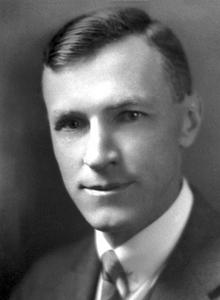William P. Murphy
American physician and Nobel laureate
William Parry Murphy (February 6, 1892 – October 9, 1987) was an American physician who shared the 1934 Nobel Prize in Physiology or Medicine with George Minot and George Whipple for their work on pernicious anemia.
Early life and education[edit | edit source]
William P. Murphy was born in Stoughton, Wisconsin, and grew up in Cudahy, Wisconsin. He attended the University of Wisconsin–Madison and later transferred to Harvard Medical School, where he earned his medical degree in 1920.
Career[edit | edit source]
After completing his education, Murphy began his career at the Peter Bent Brigham Hospital in Boston, Massachusetts. It was here that he conducted his groundbreaking research on pernicious anemia, a condition that was often fatal at the time.
Research on pernicious anemia[edit | edit source]
Murphy's research focused on the treatment of pernicious anemia, a disease characterized by the inability to absorb vitamin B12. Working alongside George Minot and George Whipple, Murphy discovered that feeding patients large amounts of liver could alleviate the symptoms of the disease. This was a significant breakthrough, as it provided a treatment for a previously incurable condition.
Nobel Prize[edit | edit source]
In 1934, Murphy, Minot, and Whipple were awarded the Nobel Prize in Physiology or Medicine for their discoveries concerning liver therapy in cases of anemia. Their work laid the foundation for the development of vitamin B12 therapy, which is still used today.
Later life[edit | edit source]
Murphy continued to work in the field of hematology and remained active in medical research throughout his life. He retired from active practice in 1958 but continued to be involved in medical education and research.
Legacy[edit | edit source]
William P. Murphy's contributions to medicine, particularly in the treatment of pernicious anemia, have had a lasting impact. His work not only saved countless lives but also advanced the understanding of hematological disorders.
Related pages[edit | edit source]
Search WikiMD
Ad.Tired of being Overweight? Try W8MD's physician weight loss program.
Semaglutide (Ozempic / Wegovy and Tirzepatide (Mounjaro / Zepbound) available.
Advertise on WikiMD
|
WikiMD's Wellness Encyclopedia |
| Let Food Be Thy Medicine Medicine Thy Food - Hippocrates |
Translate this page: - East Asian
中文,
日本,
한국어,
South Asian
हिन्दी,
தமிழ்,
తెలుగు,
Urdu,
ಕನ್ನಡ,
Southeast Asian
Indonesian,
Vietnamese,
Thai,
မြန်မာဘာသာ,
বাংলা
European
español,
Deutsch,
français,
Greek,
português do Brasil,
polski,
română,
русский,
Nederlands,
norsk,
svenska,
suomi,
Italian
Middle Eastern & African
عربى,
Turkish,
Persian,
Hebrew,
Afrikaans,
isiZulu,
Kiswahili,
Other
Bulgarian,
Hungarian,
Czech,
Swedish,
മലയാളം,
मराठी,
ਪੰਜਾਬੀ,
ગુજરાતી,
Portuguese,
Ukrainian
Medical Disclaimer: WikiMD is not a substitute for professional medical advice. The information on WikiMD is provided as an information resource only, may be incorrect, outdated or misleading, and is not to be used or relied on for any diagnostic or treatment purposes. Please consult your health care provider before making any healthcare decisions or for guidance about a specific medical condition. WikiMD expressly disclaims responsibility, and shall have no liability, for any damages, loss, injury, or liability whatsoever suffered as a result of your reliance on the information contained in this site. By visiting this site you agree to the foregoing terms and conditions, which may from time to time be changed or supplemented by WikiMD. If you do not agree to the foregoing terms and conditions, you should not enter or use this site. See full disclaimer.
Credits:Most images are courtesy of Wikimedia commons, and templates, categories Wikipedia, licensed under CC BY SA or similar.
Contributors: Prab R. Tumpati, MD

